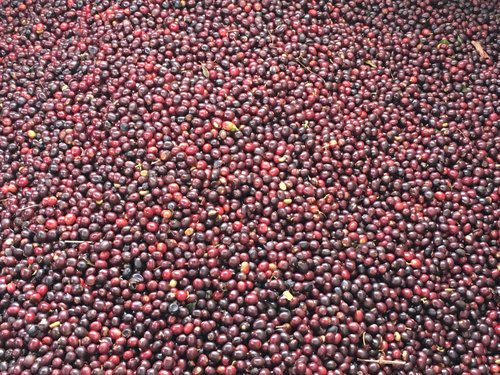
Coffee Processing Methods: Concepts and Terms


Have you ever noticed words like, “natural,” “washed,” “honey,” or “semi-washed” in the descriptions of single origin coffees?
These words refer to the coffee processing methods, which is what happens between when a ripe cherry is picked and when it is put into a burlap bag to be roasted.
Coffee grows on trees. The green beans we roast at Red Rock are actually the seeds of a flowering shrub related to Gardenia.
It’s helpful to think of a coffee bean as being similar to a cling peach, rather than a freestone apricot. It’s hard to get all the fruit off the seed. Then there’s parchment (pergamino in Spanish, and pergamino is frequently used in English, too), a papery layer that must also be hulled off the seed before roasting can take place. There’s also a mucilage layer on top of the parchment, which is very slimy and therefore requires a lot of friction to work through—or fermentation to break it down, or many weeks of drying, depending on processing method.

Natural coffee, drying on beds in its fruit
There are various cultural approaches to removing the fruit from coffee. In Ethiopia, to which Arabica coffee is native, the traditional method of fruit removal is sun drying, or natural processing. The ripe cherries are dried for several weeks, eventually turning into coffee raisins, and the dried fruit and parchment can then be winnowed off. The natural process coffees we buy are dried on African beds, raised off the ground on mesh for airflow to prevent mold growth. The extra time spent in contact with the sweet, aromatic fruit of the coffee plant imparts fruity flavors to the bean, and naturals often have bigger body.

Here’s both natural (left) and washed parchment coffee (main) drying on a patio that can be covered
The vast majority of coffee in the world is washed coffee. The ripe cherries are brought to a washing station or beneficio, the skin and pulp are removed, the pulpy beans enter a fermentation tank for around a day, and peptic enzymes in the coffee break down the slimy mucilage. Then the coffee, still in parchment, can be dried on a patio. Once the parchment is completely dry, it can be hulled. Washed coffees are clean and bright.
Washing takes a lot of water and produces a wastewater slurry that is high in sugar and bacteria, so it requires more logistics and investment to process coffee this way (safely and effectively). The wastewater can be filtered using physical filters (either sand/gravel filters or sedimentation lagoons) or even using vetiver wetlands—the grass’s deep roots suck up the coffee effluent before it can contaminate live water sources. Still, honey water contamination is a huge problem all over the world. If dumped into waterways, honey water makes people and animals sick. A plan to properly dispose of wastewater is a requirement for Organic certification of coffee farms.
There are still other methods of getting the green bean ready for export. In some areas of Indonesia, especially Sumatra, the traditional method is wet-hulling, also called semi-washed or Giling Basah.
Wet-hulled coffee starts like washed coffee, with the pulp removed with a pulper. The coffee is allowed to ferment in its mucilage for a few hours, and then a wet-huller, which is like a dry huller but with much more friction, removes the damp parchment from the seed, which is then allowed to dry on a patio,
Wet-hulling originated in the economic pressure to get coffee to market quickly—that is, farmers wanted a faster way to dry their coffee so they could get paid. Indonesia is extremely humid, and coffee takes longer to dry there than it does in, say, Central America.
The flavors imparted by wet-hulling—earthy, foresty, herbaceous—-are part of what coffee buyers are looking for in a Sumatra, even though they would be considered a processing defect in any other origin.

Pergamino (left) and green coffee (right)
The last type of process I’ll mention is honey process, called pulp natural before it got a rebranding. In this method, coffee is pulped just like washed or wet-hulled, but then it is allowed to dry in its fermenting, sticky mucilage (hence the name).
These coffees take a long time to dry and are quite susceptible to mold risk, so producers have to be careful. The increased labor and unique cup means that honey process coffees fetch more than washed, other things being equal.
In terms of flavor, they are somewhere between washed and natural, with more rounded acidity and complexity than washed, and greater clarity than natural.
We have examples of all of these processes here in store. Try Ethiopia Guji Kercha for a big, fruity natural. Any of our Central and South American coffees or our Rwanda Nkora would be a great example of washed coffees. Our Sumatras are wet-hulled, and keep an eye out for El Salvador honey to land this summer!

Honey process coffee drying on a raised bed
